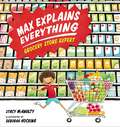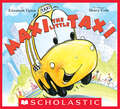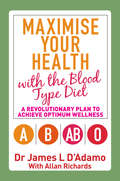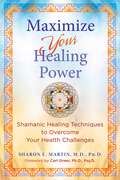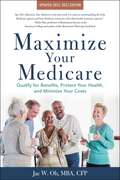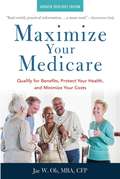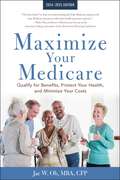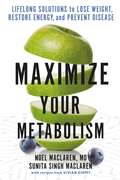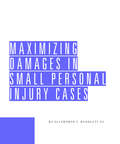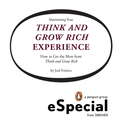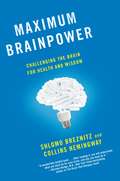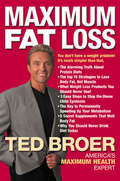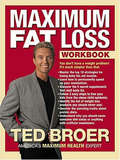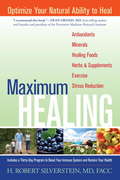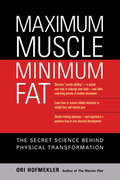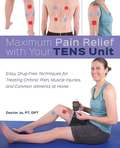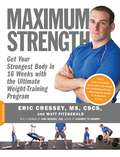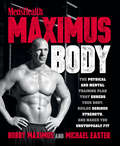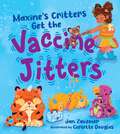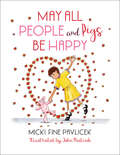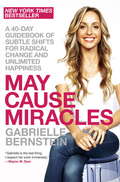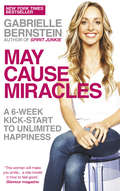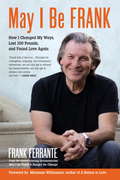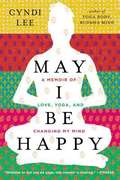- Table View
- List View
Max Explains Everything: Grocery Store Expert
by Stacy McAnultyMax's hilarious guide to the grocery store turns an everyday errand into an adventure.Max knows everything about trips to the grocery store because his parents make him go All. The. Time. Even when they run out of little things . . . like toilet paper. So he's pretty much an expert. Whether it's choosing the right breakfast cereal or surviving the obstacle course that is the produce section, Max is here to help. Having trouble talking mom into finally getting that puppy she promised? Picking up a bag of dog food might just be the push she needs! And always remember to keep your eyes on the prize--the checkout lane is your last chance to grab the real essentials. Candy! Full of humor and "helpful" tips, Max Explains Everything: Grocery Store Expert is the first in a delightful new picture book series starring kid-expert Max!A Chicago Public Library Best Book of the Year"The single greatest breakdown of grocery store shopping you'll find." --Betsy Bird, A Fuse #8 Production* "A fun romp around the grocery store that kids will relate to and a wonderful read-aloud." --Kirkus Reviews, starred review
Maxi the Little Taxi
by Elizabeth UptonHe's little! He's cute! But he's getting all dirty! This warm, charming story perfectly captures all the ups and downs of a busy little taxi's first day on the job!It's Maxi the Taxi's first day of work. What fun it is to zip and zoom all around the town!SPLASH go the mud puddles!PLIPPITY-PLOP drips the ice cream and mustard from sticky little fingers!Soon Maxi becomes so grimy and gooey that no one wants to ride with him.Who will help this dirty little taxi discover what he needs most? It's a smart little boy who takes Maxi for a noisy, tickly bath in the car wash!
Maximise Your Health with the Blood Type Diet: A Revolutionary Plan to Achieve Optimum Wellness
by James L. D'AdamoDr James D'Adamo burst onto the world of natural medicine in the 1970s with his revolutionary discovery of, and approach to, healing based on a person's blood type.Maximise Your Health with the Blood Type Diet comes almost 30 years later, as people around the world have increasingly awakened to the efficacy of natural remedies. In this fascinating book, Dr D'Adamo exhorts us to take responsibility for our own health and prevent chronic degenerative diseases using his newest discoveries, which have given him the opportunity to treat more than 50,000 patients. He explains which foods and exercises are right for each of us, what assets and liabilities we're born with, and how our minds can work to better process information. This book contains Dr D'Adamo's most up-to-date and comprehensive teachings; and includes recipes, exercise regimens and a panoply of natural therapies he recommends to the patients at his institute. Maximise Your Health... is the consummate statement on natural healing from this generation's most original naturopath. As Dr D'Adamo writes: "We are all here for a purpose, and we can only aspire to our physical and spiritual fulfillment when the body is healthy and the mind clear. Blood types are a Truth of nature and, if followed, will provide the physical and spiritual health that nature has intended for us."
Maximize Your Healing Power: Shamanic Healing Techniques to Overcome Your Health Challenges
by Sharon E. MartinBridging the mystical and the scientific for Maximum Medicine• Shows how applying shamanic and energy medicine techniques alongside allopathic medicine can shift your health and allow you to increase your life force• Reveals how to sense the energy body in order to understand imbalances and develop greater control over your health• Looks at new ways of viewing health challenges and visualizing the potential for healing using symbolic medicine wheels and the Andean symbol of the ChacanaFor more than 20 years, Dr. Sharon E. Martin has been blending allopathic medicine with ancient shamanic knowledge to help her patients not only heal but also increase their vitality. In this practical guide to her Maximum Medicine program, Dr. Martin shows how understanding the energetics behind health imbalances and applying shamanic and energy medicine techniques can shift not only our perspective but our health, change the course of illness, and allow us to increase our life force. Bridging the mystical and the scientific, Maximize Your Healing Power helps us visualize our potential for healing using symbolic medicine wheels based on the elements, the compass directions, the four perspectives, and the inner tasks of intuitive exploration, amplification, intention setting, and ritual. Viewing our organ systems through the Andean symbol of the Chacana can help us understand and overcome health challenges. Change and healing is enacted through the process of the Four As—become aware, allow, act, affirm—with a new mindfulness matrix amplifying and deepening the process toward a greater ability to self-reflect. Presenting a clear, stepwise approach to attaining mastery of your health through many case studies as well as simple practices and methods to gain control over illness, Dr. Martin shows how anyone can support their own healing and experience being more fully alive.
Maximize Your Medicare: Qualify for Benefits, Protect Your Health, and Minimize Your Costs
by Jae Oh"Jae Oh&’s Maximize Your Medicare is the best book I&’ve read on understanding all of the Medicare options and how Medicare intersects with other health insurance options." —Wade Pfau, Professor of Retirement Income at The American CollegeIncludes the Most Up-to-Date Information for 2022-2023 Confused by Medicare? Get answers from Maximize Your Medicare, an informative guide by nationally recognized expert Jae W. Oh. Maximize Your Medicare helps readers understand how and what to choose when deciding on Medicare options. This book shows readers how to: Enroll in Medicare and avoid never-ending penaltiesCompare Medigap vs. Medicare AdvantageDiscern the differences among Parts A, B, and DIncrease benefits every yearAvoid costly errorsDeal with special circumstancesGet the most from the plan Additional information for this new edition includes: Putting it Together: the steps you need to take to be a Savvy Medicare ConsumerNew coverage options for Diabetes and End-Stage Renal Disease patientsHow the ACA enhancements can change your retirement decision-making path Written in a clear and concise style, Maximize Your Medicare is a vital resource for every American aged sixty-five or older, as well as for their families and care coordinators. ged sixty-five or older, as well as for their families and care coordinators.
Maximize Your Medicare: Qualify for Benefits, Protect Your Health, and Minimize Your Costs
by Jae Oh"A must-read for both current and future retirees." —Robert Powell, Retirement Daily Includes the Most Up-to-Date Information for 2020-2021Confused by Medicare? Get answers from Maximize Your Medicare,an informative guide by nationally recognized expert Jae W. Oh. Maximize Your Medicare helps readers understand how and what to choose when deciding on Medicare options. This book shows readers how to:Enroll in Medicare and avoid never-ending penalties Compare Medigap vs. Medicare Advantage Discern the differences among Parts A, B, and DIncrease benefits every yearAvoid costly errorsDeal with special circumstances Get the most from the planWritten in a clear and concise style, Maximize Your Medicare is a vital resource for every American aged sixty-five or older, as well as for their families and care coordinators.
Maximize Your Medicare: Qualify for Benefits, Protect Your Health, and Minimize Your Costs
by Jae Oh"Jae Oh&’s Maximize Your Medicare is the best book I&’ve read on understanding all of the Medicare options and how Medicare intersects with other health insurance options." —Wade Pfau, Professor of Retirement Income at The American CollegeIncludes the Most Up-to-Date Information for 2024-2025 Confused by Medicare? Get answers from Maximize Your Medicare, an informative guide by nationally recognized expert Jae W. Oh. Maximize Your Medicare helps readers understand how and what to choose when deciding on Medicare options. This book shows readers how to: Enroll in Medicare and avoid never-ending penalties Compare Medigap vs. Medicare Advantage Discern the differences among Parts A, B, and D Increase benefits every year Avoid costly errors Deal with special circumstances Get the most from the plan Additional information for this new edition includes: Putting it Together: the steps you need to take to be a Savvy Medicare Consumer New coverage options for Diabetes and End-Stage Renal Disease patients How the ACA enhancements can change your retirement decision-making path Written in a clear and concise style, Maximize Your Medicare is a vital resource for every American aged sixty-five or older, as well as for their families and care coordinators. ged sixty-five or older, as well as for their families and care coordinators.
Maximize Your Metabolism: Lifelong Solutions to Lose Weight, Restore Energy, and Prevent Disease
by Noel Maclaren Sunita Singh MaclarenIn Maximize Your Metabolism Dr. Maclaren shares a brand new program based on cutting-edge science about how to use your body's response to insulin to boost your metabolism and easily achieve unprecedented good health.Each of us fits into one of five different body types, based on our bodies' level of insulin resistance (the book includes an easy self-assessment quiz for readers to identify their type). Maximize Your Metabolism offers unique diet and exercises plans tailored for each of the five different body types, as well as core recommendations that every type should follow, including: A low-carb diet rich in vegetables, with modest portions of meat, eggs, cheese, plain Greek yogurt , and low sugar fruits such as Granny Smith apples, berries, and green crunchy pearsAvoiding "healthy" foods that are actually hurting you: quinoa is a simple carbohydrate you should substitute with cauliflower rice, agave is actually worse for your metabolism than sugar, and probiotics are overrated (instead choose prebiotics, such as artichokes, leaks, and onions).Sleep: 6-8 hours per night (and recommended testing for sleep apnea).Exercise: 3+ times per week, as vigorous as you can, for as long as you can.This book is based on the extraordinary successful program that Dr. Maclaren has prescribed to thousands of patients with great success. Filled with specific guidance and over 30 delicious recipes, Maximize Your Metabolism is the perfect diet for readers who want to lose weight and love their lives every step of the way.
Maximizing Damages in Small Personal Injury Cases
by Ellsworth RundlettMaximizing Damages in Small Personal Injury Cases Making a decent return on small cases is getting harder. The cost to process them keeps rising, while insurers and jurors are reducing settlements and awards. Here is help. Maximizing Damages in Small Personal Injury Cases equips you with the tools you need to screen, document, negotiate, and settle or litigate your smaller cases. In addition to practical guidelines and techniques, the book offers more than 100 custom-drafted checklists and pattern-specific forms to help reduce your time and costs. These short, simple forms are specifically tailored for small cases: * Liability checklists * Interrogatories * Deposition checklists * Adjuster letters * Motions * Trial preparation checklists * Even public relations letters
Maximizing Your Think and Grow Rich Experience
by Joel FotinosHave you wanted more success in your life, but haven't known how to get it? This ebook, based on the workshop for Napoleon Hill's #1 classic bestseller Think and Grow Rich, will motivate, instruct, and inspire you on your own journey for riches, happiness, and personal satisfaction. Using the "Master Mind Method" for delving into each of the powerful "Steps to Riches," this ebook contains all the information you need not only to read the book,but also to understand it and apply it in your life. You will learn: * how to find a success partner to help you on your journey * powerful steps toward creating your Statement of Desire * how to create an action plan that will set up a system of success in your life * how to schedule to read and understand the entire book in about 90 days * how to acquire special tips and ideas, and even have a secret revealed . . . Maximizing Your Think and Grow Rich Experience is for all those who want to get to the next level in their lives!
Maximum Brainpower: Challenging the Brain for Health and Wisdom
by Shlomo Breznitz Collins HemingwayWe all understand the importance of daily exercise in keeping physically fit. But mental exercise is just as essential to our health and well-being--especially when it comes to defending against forgetfulness, memory loss, and even dementia. These and other age-associated afflictions were once regarded as all but inevitable, but in fact, as this eye-opening, inspiring book shows, there is much we can do to protect ourselves as we grow older. With the right tools, we can all maximize our brainpower and keep our minds sharp, healthy, and cognitively fit throughout life. Written by internationally renowned cognitive psychologist Shlomo Breznitz and technologist Collins Hemingway, Maximum Brainpower provides both an in-depth look at how the brain works and proven methods to increase its capabilities. Armed with the results of cutting-edge research, Breznitz and Hemingway champion in compelling detail the challenge and stimulus of continual change over the deadening effects of comfortable routine. They show how to separate good mental stress from bad, and demonstrate how hope and socialization can help delay or even fight off the worst symptoms of dementia. Did you know that experts are often less mentally agile than jacks-of-all-trades? That mental exercises such as crossword puzzles and sudoku are of minimal help in building brainpower? That multitasking poses unique dangers to the brain by presenting us with an environment in which we never evolved enough to thrive? Breznitz knows--and what's more, he knows what to do about it. Filled with colorful real-life stories and fascinating psychological experiments, many published here for the first time, this revelatory work will help adults of any age build and retain their mental acuity. Think better, live better, be better with Maximum Brainpower. Really, it's a no-brainer!From the Hardcover edition.
Maximum Energy Cookbook And Natural Food Preparation Manual
by Sharon BroerThis book shares how to shop, prepare and cook naturally, healthy and teaches how to have Maximum energy and health.
Maximum Fat Loss
by Ted BroerMany experts agree that a high-carbohydrate, low-fat diet should be an effective way to gain control of weight problems. But statistics show that though we are consuming less fat, Americans are actually becoming fatter, not "fitter." Ted Broer challenges traditional thinking and offers a healthy alternative that reveals new findings in biochemistry. Maximum Fat Loss shows readers why high-carb/low-fat diets don't work-and what does. Readers will learn how to maintain muscle mass and increase their metabolism while losing body fat. They'll discover why carbohydrates increase body fat, how hormones control weight loss and gain, genetic predisposition for fat gain, what foods to eat and what foods to avoid, what supplements produce healthy results, and much, much more. Maximum Fat Loss takes advantage of the latest research to bring a better solution to the problem of weight gain.
Maximum Fat Loss Workbook
by Ted BroerNo country on earth is more preoccupied or has a greater fear of and aversion to dietary fat than the United States. Yet Americans are more overweight than any other country. A perfect companion to the trade book by the same name, the Maximum Fat Loss Workbook shows readers why high-carb/low-fat diets don't work-and what does. In this workbook, Ted Broer will guide readers through a step-by step process allowing them to not only lose weight-but lose fat and be healthy. Readers will learn practical applications that will teach them how to easily maintain muscle mass while increasing their metabolism and decreasing body fat.
Maximum Healing
by H. Robert Silverstein Michael B. Teiger Laurence GoldsteinBased on his CAIM (Complementary-Alternative-Integrative-Medicine) approach, Dr. H. Robert Silverstein outlines a program that integrates modern medical practices with alternative and ancient forms of healing. Recalling the work of Andrew Weil and Larry Dossey, the book argues that our self-healing mechanism--the immune system--is more powerful than we think. If we make wise diet and lifestyle changes, says Silverstein, the immune system can function at an optimal level, restoring health and preventing future illnesses.Part I explores the five keys to health--five critical domains that affect the immune system: the quality of our air, water, and food; the degree of physical activity we engage in; and the degree of positive feelings and stability in our psychological and emotional lives. Providing a clear description of the immune system, the book details the elements of good health, which include healing foods, minerals, antioxidants, herbs, physical activity, and the avoidance of unrealistic thinking. Part II contains a thirty-day program divided into four parts: diet, exercise, outlook on life, and creating balance in daily life. The book concludes with over sixty restorative recipes designed to boost immunity and help fight chronic illnesses.From the Trade Paperback edition.
Maximum Muscle Minimum Fat: The Secret Science Behind Physical Transformation
by Ori HofmeklerDiet and fitness books appear at a dizzying rate – and with a wealth of dubious claims – in a culture facing increasing health problems based on a sedentary lifestyle. Ori Hofmekler’sMaximum Muscle, Minimum Fatpulls out of the pack by focusing on the biological principles that dictate muscle gain and fat loss. Written for the widest readership–competitive athletes, bodybuilders, trainers, martial artists, sports nutritionists and coaches, dieters, and anyone concerned about their health–the book builds on the concepts popularized inTheWarrior Diet. Author Hofmeklerdescribes in simple, lay terms how under-eating and fasting can trigger an anabolic switch that stimulates growth and rejuvenation; how to reengineer the body at the cellular level to burn fat and build muscles; and how to naturally manipulate the body’s hormones for rapid muscle fusion and faster fat breakdown. Maximum Muscle, Minimum Fatoffers smart strategies for taking advantage of hunger to stimulate growth, burn fat, and boost brain power; techniques for turning insulin into a muscle builder instead of a fat gainer; and methods for shattering training and diet plateaus–in the process enhancing metabolic function, improving performance, and increasing the capacity to gain, and sustain, prime health.
Maximum Pain Relief with Your TENS Unit: Easy, Drug-Free Techniques for Treating Chronic Pain, Muscle Injuries and Common Ailments at Home
by Doctor JoTips, Techniques, and Step-by-Step Color Photos to Get the Most Out of Your TENS UnitPain can hinder every aspect of your life, making even the simplest of tasks unbearable. Instead of endlessly ingesting only partially effective over-the-counter painkillers or turning to dangerously addictive opioids from your doctor, there is now a powerful at-home alternative solution: TENS. Transcutaneous electrical nerve stimulation (TENS) units can decrease acute and chronic pain while significantly reducing, or even eliminating, the need for medication.For beginners to more advanced users, this book has solutions for everyone. It offers not only an overview of how the units work, but also how to properly place the electrodes and how much power to use to get the best results for various injuries and ailments throughout the body, including:Upper and Lower Back PainNeck and Shoulder TightnessHamstring and Calf StrainsFibromyalgiaPeripheral NeuropathyTension Headaches
Maximum Strength: Get Your Strongest Body in 16 Weeks with the Ultimate Weight-Training Program
by Matt Fitzgerald Eric Cressey CscsMost of the 23 million American men who lift weights do so to get bigger; unfortunately, many of them are going nowhere with watered-down bodybuilding routines that don’t help them actually get stronger. Eric Cressey’s cutting-edge four-phase program, featuring constant progression, variation, and inspiring goals, keeps you focused on increasing strength along with muscle mass, helping you achieve the fittest, most energetic, and best-looking body you’ve ever had-with fewer hours at the gym.
Maximus Body: The Physical and Mental Training Plan That Shreds Your Body, Builds Serious Strength, and Makes You Unstoppably Fit
by Bobby Maximus Michael EasterMen's Health magazine's #1 personal trainer delivers cutting-edge, high-intensity workouts to help you pack serious muscle and become unstoppably fit. From the man responsible for the gym that trained the actors in the movie 300 comes cutting-edge fitness strategies, 100 workouts, and a training plan that has successfully transformed A-list actors and actresses, elite special-forces soldiers, all-star athletes, and everyday men and women. With Bobby Maximus’s guidance you too can become one of the most insanely fit people the world has ever seen. The diets and workouts that promise easy results in minutes per day have tricked masses into wasting their money on false promises. Supplements, smoothies, and 4-minute workouts aren’t getting people any fitter. Getting that shredded body requires real commitment and real work—and Bobby can show you how. Maximus Body features circuit-style workouts that will push you to your limits and work your whole body. With a plethora of exercises like “Don’t Ask Me About Your Abs,” that work your core with a combination of sit ups, push ups, pull ups, and even leg raises, you can develop an exercise routine that fits your needs. Whether you are overweight and trying to get back into shape, or a high-level athlete trying to gain that extra edge, Maximus Body offers up thousands of once-secret ways to burn fat, add lean muscle, reveal a shredded 8-pack, and build mind-bending physical fitness.
Maxine's Critters Get the Vaccine Jitters: A Cheerful And Encouraging Story To Soothe Kids' Covid Vaccine Fears
by Jan ZauzmerA shot can be a little frightening—but it’s quick, as quick as lightning! When Maxine tells her pets, “Let’s get to the vet!” Scott does not want a shot. Jervis is nervous, Franky is cranky, Biffy is iffy, and Cary is wary. Can Maxine help her critters get over their jitters . . . ? Perfect for any child afraid of shots or needles, this rhyming book in free meter is a “must-read-aloud”! Spunky Maxine takes charge of her vaccine fears with a playful game of pretend: Her adorable stuffed animals are the patients, and Dad steps in as the “vet.” Just in time for the kids’ covid vaccine—and relevant to any pediatric shot—Maxine’s Critters Get the Vaccine Jitters will delight children ages 5 and under who face this understandable fear. No need to be grouchy about this little ouchy!
May All People and Pigs Be Happy
by Micki Fine PavlicekPigalina teaches Claire the loving-kindness meditation to help Claire embrace the world with compassion and caring May All People and Pigs Be Happy follows seven-year-old Claire and her stuffed animal Pigalina. From Pigalina, Claire learns a simple meditation that helps her to feel kinder toward herself and spread caring and love to others. The loving-kindness meditation can be practiced by anyone regardless of religion to cultivate loving presence, friendship, tenderness, and love. This book is perfect for those with or without a background in the loving-kindness meditation.
May Cause Miracles
by Gabrielle BernsteinFrom the popular and exciting author of Spirit Junkie and Add More ~Ing to Your Life comes this practical and fun 40-day guidebook of subtle shifts for radical change and unlimited happiness. Are you ready to work miracles? Gabrielle Bernstein believes that simple, consistent shifts in our thinking and actions can lead to the miraculous in all aspects of our daily lives, including our relationships, finances, bodies, and self-image. In this inspiring guide, Gabrielle offers an exciting plan for releasing fear and allowing gratitude, forgiveness, and love to flow through us without fail. All of which, ultimately, will lead to breathtaking lives of abundance, acceptance, appreciation, and happiness. With May Cause Miracles, readers can expect incredible transformation in 40 powerful days: simply by adding up subtle shifts to create miraculous change.From the Hardcover edition.
May Cause Miracles: A 40-Day Diet for the Mind
by Gabrielle BernsteinFrom the popular and exciting author of Spirit Junkie and Add More ~Ing to Your Life comes this practical and fun six-week diet of the mind for transforming fear into love and discovering true and lasting happiness.Gabrielle Bernstein's incredible new title, May Cause Miracles, is the best yet as she shows you that miracles in your personal life are easily at hand. Gabrielle Bernstein refers to her positive lifestyle as the Lovetarian Way. Like the vegetarian who adopts a certain way of eating and living, the Lovetarian embraces the ingredients of leading a centered, spiritual life, and in this case, one imbued with the teaching of A Course in Miracles. In this inspiring guide, Gabrielle offers a six-week plan to cleanse our spiritual systems by tossing aside fear and living off the foods of gratitude, forgiveness, and love. All of which, ultimately, will lead to lives of abundance, acceptance, appreciation and enlightenment.
May I Be Frank
by Marianne Williamson Frank Ferrante"What happens when Tony Soprano meets Deepak Chopra? That's how people have described my story. I might throw some Woody Allen in there and a dash of Hunter S. Thompson." So says Frank Ferrante of his amazing journey from obesity and drug addiction to vibrant health and happiness. At 54 years old, Ferrante was the least likely candidate for a major personal transformation. He weighed close to 300 pounds and suffered from a slew of issues that were his unhappy legacy as an ex-junkie and ex-alcoholic: hepatitis C, chronic fatigue, joint pain, respiratory issues, depression, suicidal thoughts, and a libido that had gone into early retirement. He thought that "vegan" was a planet, "wellness" was not in his vocabulary, and he couldn't be bothered with self-help. He was for those very reasons the best candidate for a major personal transformation. One day, he stumbled into Café Gratitude--a vegan raw food restaurant run by three 20-something hipsters. Unbeknownst to him, they'd been thinking about finding someone to put on a raw food diet and making a documentary that would be the polar opposite of Super Size Me. Ferrante was looking for something, anything, to create a shift in his life. As he says, "Like zillions of people, I was hungry not so much for food, but for love." Never mind that he was old enough to be the boys' father or that he'd ridiculed the New Age herd for years--he accepted them pretty much on the spot as his new "transformational cheerleaders." With the young men's unexpected support and guidance, Ferrante began a redemptive odyssey that included a plant-based diet, yoga, and daily affirmations--but then faced a battle for his life when his underlying addictions rose up to claim him. May I Be Frank chronicles Ferrante's experience of being the subject of a physical, mental, and spiritual makeover and also describes what happened next, post-transformation: he learned to love again.From the Trade Paperback edition.
May I Be Happy
by Cyndi Lee"For the millions of people--especially women--who fight the fat talk in their heads, her words will be familiar and comforting." --Associated Press In the opening pages of her memoir, Cyndi Lee shares a surprising revelation. Despite her success as a dancer, choreographer, and yoga teacher, she was caught in a lifelong cycle of self-judgment about her body. Inspired by her students, Lee embarked on a journey of self-discovery--around the globe and within herself--and sought the counsel of knowing women, including Jamie Lee Curtis, Dr. Christiane Northrup, and Louise Hay. Applying the ancient Buddhist practice of loving-kindness meditation, Lee comes to learn that compassion is the only antidote to hate. By becoming her own best student, Lee internalizes the strength, stability, and clarity she seeks to impart.
